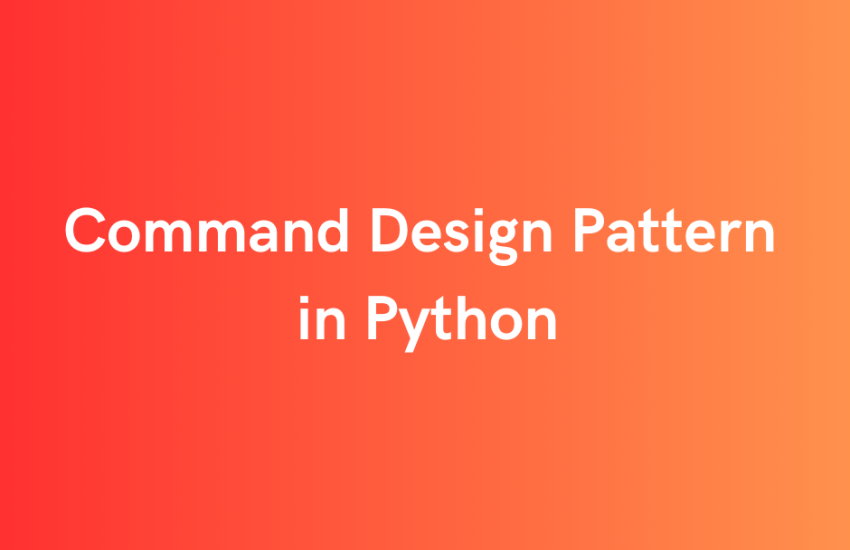The Command Design Pattern is a fundamental behavioral design pattern that focuses on encapsulating method invocation, allowing for the decoupling of clients and receivers, and enabling extensibility and flexibility in code design. In this comprehensive guide, we’ll delve into the intricacies of the Command Pattern, its implementation in Python, and its various applications.
Understanding the Command Design Pattern:
By representing requests as objects, this pattern facilitates the decoupling of the sender and receiver of a request. This separation enables various features such as queuing of requests, logging of commands, and even support for undo operations.
Key Components of the Command Design Pattern:
The Command Design Pattern consists of several key components, each fulfilling a specific role in the pattern’s structure. Understanding these components is crucial for effectively implementing the pattern and leveraging its benefits. Let’s delve deeper into each component
1. Command Interface:
The Command Interface declares an abstract method or set of methods that encapsulate the behavior of a command.
Role: It serves as a contract for all concrete command classes, defining the interface that concrete commands must implement.
Purpose: By defining a common interface, the Command Interface enables polymorphic behavior, allowing different types of commands to be executed uniformly by the invoker.
2. Concrete Command:
Role: Each Concrete Command class represents a distinct action that can be performed by the system. It binds the action to its receiver, effectively encapsulating the request as an object.
Purpose: Concrete Command classes promote encapsulation and separation of concerns by encapsulating individual commands as objects. They allow for the modular addition of new commands without modifying existing code.
3. Receiver:
The Receiver class contains the actual implementation of the operations associated with executing a command.
Role: Receivers are responsible for performing the actual work when a command is executed. They encapsulate the functionality that needs to be invoked in response to a command.
Purpose: By separating command execution from command implementation, Receivers promote loose coupling and encapsulation. They enable different receivers to handle the same command differently, enhancing flexibility and maintainability.
4. Invoker:
The Invoker class is responsible for initiating and executing commands.
Role: Invokers maintain a reference to a Command object and trigger its execution when necessary. They act as an intermediary between the client and the receiver, abstracting the details of command execution.
Purpose: Invokers decouple the client from the concrete implementation of commands and receivers. They provide a uniform interface for executing commands, regardless of their type or implementation details.
Example: Implementation in Python:
Let’s illustrate the Command Pattern with a practical example involving a remote control that can operate different electronic devices such as a television, stereo, or lights.
from abc import ABC, abstractmethod
# Command Interface
class Command(ABC):
@abstractmethod
def execute(self):
pass
# Concrete Command
class TurnOnCommand(Command):
def __init__(self, device):
self.device = device
def execute(self):
self.device.turn_on()
# Receiver
class Television:
def turn_on(self):
print("Television is ON")
# Invoker
class RemoteControl:
def __init__(self):
self.command = None
def set_command(self, command):
self.command = command
def press_button(self):
if self.command:
self.command.execute()
# Client
if __name__ == "__main__":
television = Television()
turn_on_command = TurnOnCommand(television)
remote_control = RemoteControl()
remote_control.set_command(turn_on_command)
remote_control.press_button()
In this example:
- Command is represented by the Command interface, providing a contract for concrete command classes.
- Concrete Command is exemplified by the TurnOnCommand, which binds the action of turning on with the receiver (Television).
- Receiver is the Television class, which encapsulates the functionality of turning on the television.
- Invoker is the RemoteControl, which sets the command to execute and invokes it upon user interaction.
Benefits of the Command Pattern:
- Decoupling: The Command Pattern promotes loose coupling between objects, allowing the sender and receiver of a request to vary independently.
- Extensibility: It provides a straightforward mechanism for adding new commands without modifying existing code, enhancing the maintainability and scalability of the system.
- Undo Operations: The encapsulation of commands as objects facilitates the implementation of undo functionality by storing command history or parameters.
Applications of the Command Pattern:
The Command Pattern finds application in various domains, including:
- Graphical User Interfaces (GUIs) for implementing undo and redo functionalities.
- Multi-level menu systems in applications, where each menu item can be considered a command.
- Transactional systems, such as banking applications, where commands represent individual transactions that can be committed or rolled back.
In conclusion, the Command Design Pattern is a versatile and powerful tool for designing flexible, extensible, and maintainable software systems. By encapsulating requests as objects, it promotes decoupling, extensibility, and encapsulation of behavior, making it a valuable addition to any developer’s toolkit.




